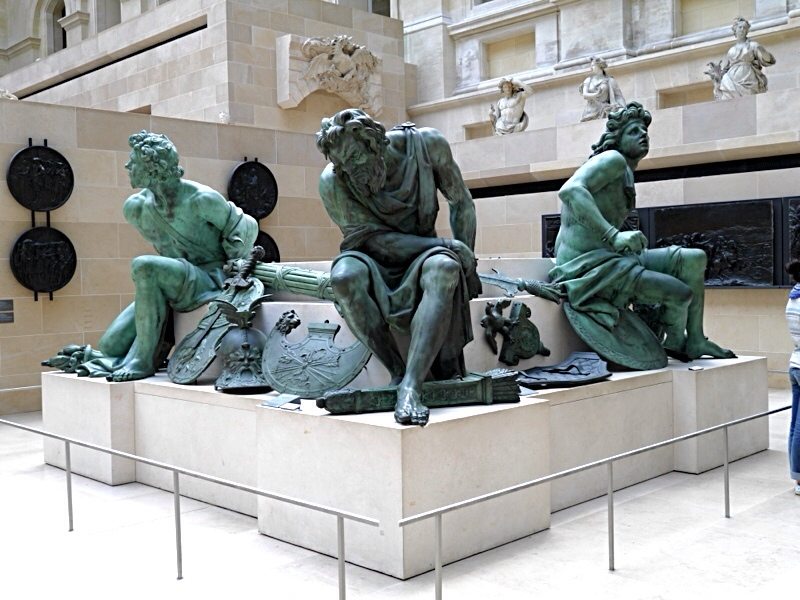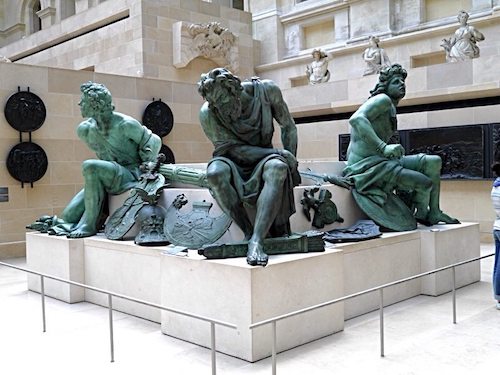Captives, Martin van den Bogaert/Desjardins (Louvre Museum)
Taken from the pedestal of the statue in the Place des Victoires, these captives represent the nations defeated by the Treaty of Nijmegen (1679). Each expresses a different reaction to captivity: revolt, hope, resignation, or grief. They were first kept in the Invalides (1804-1939) then allocated to the Louvre in 1960 and placed in the grounds of the Château de Sceaux from 1961 to 1992.
The Treaties of Peace of Nijmegen (Négotiations de Nimegue or Négotiations de la Paix de Nimègue; Friede von Nimwegen) were a series of treaties signed in the Dutch city of Nigemen between August 1678 and December 1679. The treaties ended various interconnected wars among France, the Dutch Republic, Spain, Brandenberg, Sweden, Denmark, the Prince-Bishopric of Münster, and the Holy Roman Empire. The most significant of the treaties was the first, which established peace between France and the Dutch Republic, and placed the northern border of France in very nearly its modern position.
The most important lesson that the Treaties of Nijmegen can teach us – and Europe – is that consultation, dialogue and mutual respect – immediately and in the long term – can lead to European peace and tolerance. You have to make the attempt if you are ever going to succeed. The Peace of Nijmegen was an early attempt at a continent-wide and therefore a European peace.
In many European countries, the Treaties of Nijmegen have gone down as a key event in European history. In 1678 and 1679, Nijmegen played host to negotiators from dozens of European countries and city-states in order to bring an end to various wars on the European continent. Spain, France, Sweden, the Republic of the Seven United Netherlands and the Holy Roman Empire to name but a few signed peace treaties that have become known internationally as the “Treaties of Nijmegen”. Dialogue, tolerance and negotiations at a European level led to peace.
The Treaties of Nijmegen medal was awarded for the first time ever in 2010 to Jaques Delores and every two years thereafter. The recipient was to be a key international figure who has worked hard for and/or shown commitment to peace on the European continent and the international role and position of Europe. The Treaties of Nijmegen (1678 – 1679) can be seen as one of the first examples of European agreement and cooperation. The Treaties of Nijmegen medal is an initiative of NijmegenCity Council, the RadboudUniversityNijmegen, Royal Haskoning and the Dutch Ministry of Foreign Affairs.
Upon being appointed chairman of the European Commission in 1985, a position which he held until 1995, Jacques Delors was Economics and Finance Minister in France. His key goal was to create a European common market, and he made great efforts to open borders between European member states, since according to his vision economic integration should precede European unity. Not only did Delors take into account the economic aspect of European unity, but he also gave particular consideration to social coherence in Europe and the promotion of solidarity between rich and poor parts of the continent.
What could be considered Delors’ most important role came about straight after the fall of the Berlin Wall on 9 November 1989. Europe was in a state of confusion, even more so after the German Chancellor Kohl announced his aim in the Bundestag on 28 November 1989: unity and reunification of East and West Germany. Delors succeeded in turning German and French interests into European ones. He then prepared the Maastricht Treaty (1992), which included the decision to introduce the euro and agreements about a common foreign policy, which the European Council was responsible for.
Funny how history has a knack for repeating itself. This group of statues is as relevant as it was on the day it was unveiled.


